

Livestock producers have been raising cattle for generations using a variety of different production methods. An eventual crossroad at the meat case for consumers in deciding whether to pay an added premium for their favorite steak or roast based on what they believe to be worth the increase in price. Unfortunately, many misinterpret some major cattle production methods that significantly impact how we raise our beef cattle. One of the most common debates is that between grass fed or grain fed beef.
There are a number of differences between these two production systems, but the most important point to note is the discrepancies between “fed” and “finished”. Most cattle in the United States are fed grass for well over half of their life before transitioning to a high energy grain diet. In contrast, a “grass finished” diet is one where cattle are raised, weaned and finished on grass or a blend of forages.
In the United States, the vast majority of calves are born and raised on a ranch, where the average herd size is around just under 50 head. While they are on the ranch, they consume a diet of mom’s milk and grass for approximately six months and then are weaned and backgrounded, or started on feed where they will consume mostly grass and supplemental feed/grain. After backgrounding, calves will enter the finishing lot to develop the small flecks of fat found between the muscle fibers of meat products, otherwise known as “marbling” (the more marbling you have, the better the eating experience!).
Grain fed calves will be fed a professionally formulated and balanced, high energy diet consisting of ingredients such as corn, dried distillers grains, roughages and a blend of forages. This diet allows cattle to optimize weight gain while maximizing consumer eating experience. Grass finished cattle will strictly be fed a blend of forages. As a result, they will reach their desired endpoint at a much later date than grain finished cattle. If grain and grass fed steers entered the finishing lot at the same time, the grass fed steers could take up to 18 months longer to reach their peak finishing condition than the grain finished steers. This represents a significantly greater amount of feed, and land resource commitment that is difficult to sustain.
Building on the impact of consumer buying power, a common myth surrounding grass finished beef is that it is somehow healthier than grain finished beef due to their differing nutrient compositions. In reference to leanness, grass-finished beef strip steaks were leaner than grain-finished, but both grain and grass finished samples were considered lean as they possessed fat contents less than 4.3% (Leheska et al., 2008).
Additionally, while grass finished beef does contain higher levels of Omega-3 fatty acids compared to grain finished beef, there were no significant differences in Omega-6 fatty acids or total cholesterol (Leheska et al., 2008). Any nutrient differences between grass and grain finished beef are minimal. Neither grass, nor grain finished beef is healthier than one or the other. Both are excellent sources of essential vitamins and nutrients necessary to the human diet.
Concisely, beef is a safe, healthy choice capable of providing important vitamins and nutrients to the human diet. Certified Hereford Beef is premium quality, grain finished beef raised by local U.S. Hereford ranching families dedicated to producing an exceptional product your family can enjoy.